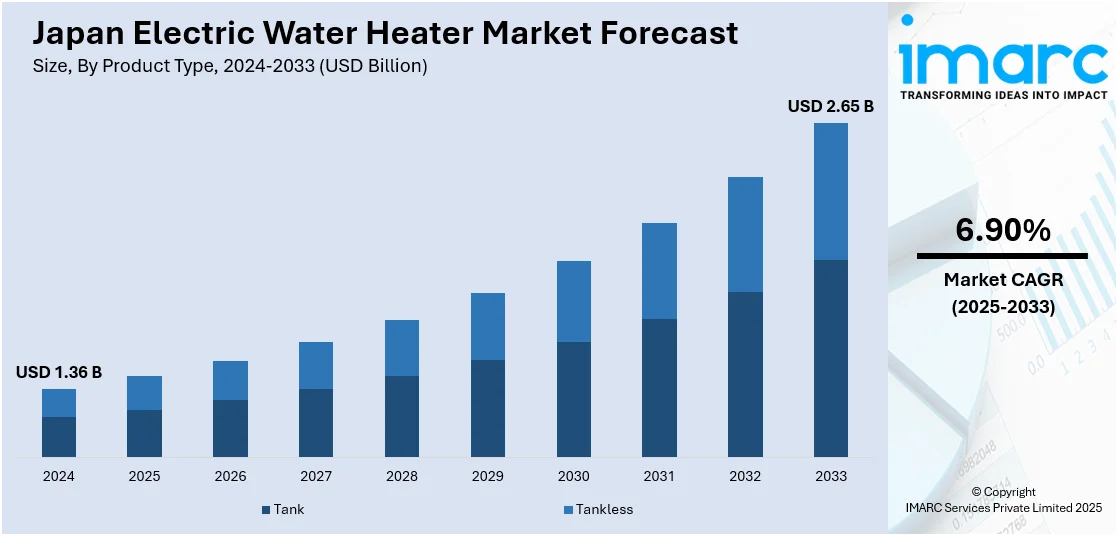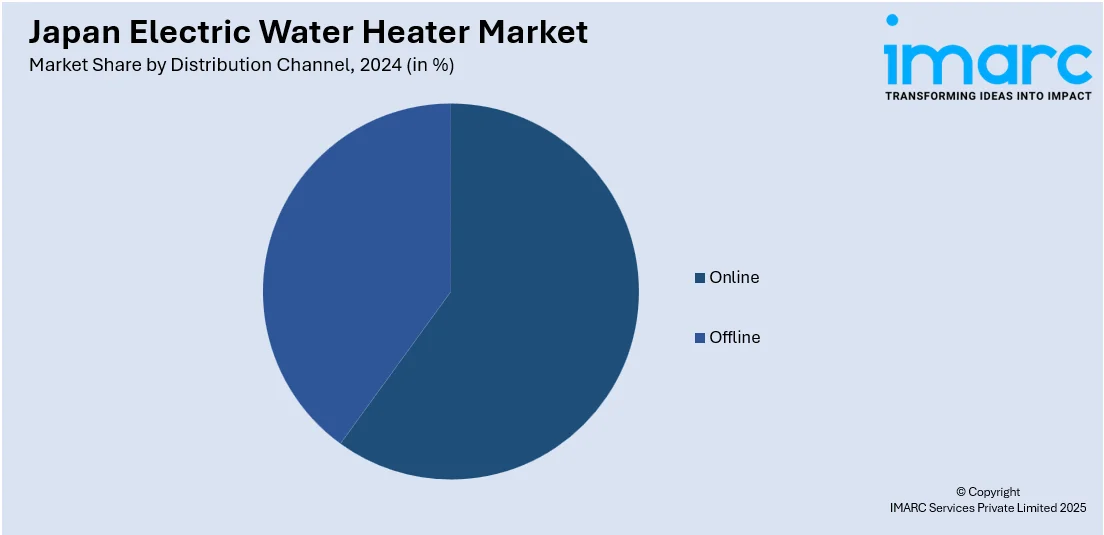
Japan Electric Water Heater Market Size, Share, Trends and Forecast by Product Type, Capacity, Distribution Channel, End User, and Region, 2025-2033
Japan Electric Water Heater Market Overview:
The Japan electric water heater market size reached USD 1.36 Billion in 2024. Looking forward, IMARC Group expects the market to reach USD 2.65 Billion by 2033, exhibiting a growth rate (CAGR) of 6.90% during 2025-2033. The market is driven by technological innovations that enhance efficiency and user convenience, fueling consumer demand for advanced water heating systems. Furthermore, the shift towards more energy-efficient appliances is pushing the adoption of environmentally friendly options, particularly those with heat pump technology. These factors continue to align with government policies promoting sustainability, further augmenting the Japan electric water heater market share.
|
Report Attribute
|
Key Statistics
|
|---|---|
|
Base Year
|
2024
|
|
Forecast Years
|
2025-2033
|
|
Historical Years
|
2019-2024
|
| Market Size in 2024 | USD 1.36 Billion |
| Market Forecast in 2033 | USD 2.65 Billion |
| Market Growth Rate 2025-2033 | 6.90% |
Japan Electric Water Heater Market Trends:
Technological Advancements in Electric Water Heating Solutions
Technological innovations in electric water heating solutions are a key driver of the growth of the market. Advances in energy efficiency, installation ease, and control of the system have redefined customer preferences. Companies emphasize on the inclusion of smart technologies, providing customers with more control over their energy usage and water heating conditions. The innovations enhance the overall user experience and efficiency, maintaining even water temperature while reducing wastage of energy. These features increase the reliability and popularity of these systems, which meet the increasing demand for sustainable and affordable solutions. Additionally, the advancements in materials like heat pump technology that utilizes ambient air for heating has minimized operational expenses. On September 6, 2024, Mitsubishi Electric launched its Climaveneta EW-HT-G05 water-to-water heat pump for commercial and industrial applications. The heat pump, available in various sizes (73 kW to 129.3 kW), offers high-temperature water production of up to 78°C, with a coefficient of performance of up to 3.77. It is designed for applications such as IT cooling, district heating, and industrial process heat recovery, and can be combined with Mitsubishi's other heating and cooling solutions. Such technological advancements align with consumer expectations of sustainability, especially in markets where energy conservation is becoming a key factor in purchasing decisions. As the key players continues to innovate, these developments are expected to drive Japan electric water heater market growth, contributing to long-term sustainability in the sector.

Growing Consumer Demand for Energy-Efficient Appliances
The increasing preference for energy-efficient home appliances has been a significant driver for the market. Japanese consumers are increasingly inclined towards products that not only offer high performance but also help reduce energy consumption, in line with environmental concerns and rising utility costs. Water heating, being one of the largest contributors to household energy consumption, presents a considerable opportunity for innovation aimed at reducing electricity use. Electric water heaters, particularly those utilizing heat pump technology, have seen increasing adoption as they offer a greener alternative to traditional water heating methods. Notably, on April 18, 2025, it was announced that shipments of EcoCute CO2 heat pump water heaters surpassed 10 million units since their launch. First introduced by Corona Corporation in 2001, the EcoCute technology has been adopted by major Japanese manufacturers, including Daikin, Panasonic, and Mitsubishi Electric. The EcoCute system, part of Japan's CO2 reduction efforts under the Kyoto Protocol, significantly reduces energy demand for domestic hot water, which previously accounted for a large portion of energy consumption in Japan. Additionally, government incentives and energy regulations focused on reducing household carbon footprints have led consumers to seek solutions that promise energy efficiency without sacrificing functionality. These trends align with broader shifts in consumer behavior, where sustainability and lower energy bills are key drivers. As these factors continue to resonate with the Japanese population, demand for energy-efficient water heating products is expected to remain robust, further influencing the market dynamics.
Japan Electric Water Heater Market Segmentation:
IMARC Group provides an analysis of the key trends in each segment of the market, along with forecasts at the country and regional levels for 2025-2033. Our report has categorized the market based on product type, capacity, distribution channel, and end user.
Product Type Insights:
- Tank
- Tankless
The report has provided a detailed breakup and analysis of the market based on the product type. This includes tank and tankless.
Capacity Insights:
- Less Than 100 Liters
- 100 to 400 Liters
- More Than 400 Liters
The report has provided a detailed breakup and analysis of the market based on the capacity. This includes less than 100 liters, 100 to 400 liters, and more than 400 liters.
Distribution Channel Insights:

- Online
- Offline
The report has provided a detailed breakup and analysis of the market based on the distribution channel. This includes online and offline.
End User Insights:
- Residential
- Commercial
- Industrial
The report has provided a detailed breakup and analysis of the market based on the end user. This includes residential, commercial, and industrial.
Regional Insights:
- Kanto Region
- Kansai/Kinki Region
- Central/Chubu Region
- Kyushu-Okinawa Region
- Tohoku Region
- Chugoku Region
- Hokkaido Region
- Shikoku Region
The report has also provided a comprehensive analysis of all major regional markets. This includes Kanto Region, Kansai/Kinki Region, Central/Chubu Region, Kyushu-Okinawa Region, Tohoku Region, Chugoku Region, Hokkaido Region, and Shikoku Region.
Competitive Landscape:
The market research report has also provided a comprehensive analysis of the competitive landscape. Competitive analysis such as market structure, key player positioning, top winning strategies, competitive dashboard, and company evaluation quadrant has been covered in the report. Also, detailed profiles of all major companies have been provided.
Japan Electric Water Heater Market News:
- On November 19, 2024, Rheem, a subsidiary of Paloma Group based in Nagoya, Japan, announced upgrades to its ProTerra® Hybrid Electric Heat Pump Water Heater, enhancing installation and service efficiency. The new design reduces installation time and includes features like quick-install connections, a duct-ready design, and smart tech integration with EcoNet® for energy savings. ProTerra is ENERGY STAR® certified and uses up to 75% less energy than standard electric water heaters, qualifying for tax credits and rebates.
Japan Electric Water Heater Market Report Coverage:
| Report Features | Details |
|---|---|
| Base Year of the Analysis | 2024 |
| Historical Period | 2019-2024 |
| Forecast Period | 2025-2033 |
| Units | Billion USD |
| Scope of the Report |
Exploration of Historical Trends and Market Outlook, Industry Catalysts and Challenges, Segment-Wise Historical and Future Market Assessment:
|
| Product Types Covered | Tank, Tankless |
| Capacities Covered | Less Than 100 Liters, 100 to 400 Liters, More Than 400 Liters |
| Distribution Channels Covered | Online, Offline |
| End Users Covered | Residential, Commercial, Industrial |
| Regions Covered | Kanto Region, Kansai/Kinki Region, Central/Chubu Region, Kyushu-Okinawa Region, Tohoku Region, Chugoku Region, Hokkaido Region, Shikoku Region |
| Customization Scope | 10% Free Customization |
| Post-Sale Analyst Support | 10-12 Weeks |
| Delivery Format | PDF and Excel through Email (We can also provide the editable version of the report in PPT/Word format on special request) |
Key Questions Answered in This Report:
- How has the Japan electric water heater market performed so far and how will it perform in the coming years?
- What is the breakup of the Japan electric water heater market on the basis of product type?
- What is the breakup of the Japan electric water heater market on the basis of capacity?
- What is the breakup of the Japan electric water heater market on the basis of distribution channel?
- What is the breakup of the Japan electric water heater market on the basis of end user?
- What is the breakup of the Japan electric water heater market on the basis of region?
- What are the various stages in the value chain of the Japan electric water heater market?
- What are the key driving factors and challenges in the Japan electric water heater market?
- What is the structure of the Japan electric water heater market and who are the key players?
- What is the degree of competition in the Japan electric water heater market?
Key Benefits for Stakeholders:
- IMARC’s industry report offers a comprehensive quantitative analysis of various market segments, historical and current market trends, market forecasts, and dynamics of the Japan electric water heater market from 2019-2033.
- The research report provides the latest information on the market drivers, challenges, and opportunities in the Japan electric water heater market.
- Porter's five forces analysis assist stakeholders in assessing the impact of new entrants, competitive rivalry, supplier power, buyer power, and the threat of substitution. It helps stakeholders to analyze the level of competition within the Japan electric water heater industry and its attractiveness.
- Competitive landscape allows stakeholders to understand their competitive environment and provides an insight into the current positions of key players in the market.
Need more help?
- Speak to our experienced analysts for insights on the current market scenarios.
- Include additional segments and countries to customize the report as per your requirement.
- Gain an unparalleled competitive advantage in your domain by understanding how to utilize the report and positively impacting your operations and revenue.
- For further assistance, please connect with our analysts.
 Request Customization
Request Customization
 Speak to an Analyst
Speak to an Analyst
 Request Brochure
Request Brochure
 Inquire Before Buying
Inquire Before Buying




.webp)




.webp)












